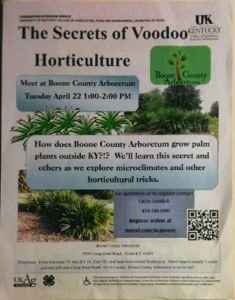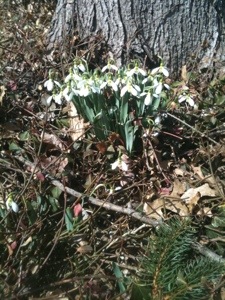The forcast for the morning is a balmy 25 degrees F ! My Japanese Maple is in a Southern exposure and has begun putting on tender new leaves. The only option to protect this new vegetation is to cover it which creates an insulation barrier. It’s not exactly a good fashion statement, but I’m giving my fancy little tree the best chance to avoid damage and possible a costly setback this season.
Tag Archives: #whmag
The Beauty Of Nature
This is what I saw this morning as I left my home. Two forces coexisting in a beautiful battle, Winter desiring to continue on and on the other side Spring trying to usher in new beginnings. I’m more than ready to leave the cold behind, the Winter snow has worn out its welcome. Beautiful or not I’m ready for Spring.
Who’s Your Pawpaw ?
What an incredible time of the year it is in Northern Kentucky with Spring finally arriving, and I was fortunate enough to attend one of the first classes of the new season sponsored by the Boone County Arboretum entitled, “Who’s Your Pawpaw?”. This class proved to be more than just have a catchy title.

Sheri Crabapple of Kentucky State University Community Research Service was quite knowledgeable about pawpaw.

Ron Powell of Fox Paw Ridge Farm and president of North American Pawpaw Growers Association was available to share his knowledge and expertise with those in the class. This pawpaw duo guided the class every step of the way through the process of bud grafting pawpaw. By the end of the class I was feeling pretty good about the work i had completed and can’t wait to see the results of my work.


Oh, did I mention that at the end of the class you walk away with your Pawpaw trees you just finished grafting.
If you would like more info please contact Ron Powell, this is his business card.
Sheri Crabtree’s contact info is posted below in the image, just click on the image to view a larger size image.
Brown is the new green this year
As the weather breaks and you get out into your landscape your very likely to find leaves that are normally green are actually brown this year.

Why you ask? Is it dead you ask?

Well this is the same boxwood from above, and as you can see there are plenty of green leaves on the inside.

This Southern Magnolia might look like it’s half dead, but actually it isn’t.


These leaves are dead, but this tree will put out new leaves sometime late May or very early June.



These Cherry Laurel look really bad, from a distance they look dead. But wait, as you take a closer look.



Do you see all of those bumps along the stems?
Those are new buds that will develop into new leaves as the weather continues to warm and the days become longer. So the answer is, no the tree or shrub is not dead or dying. So why are the leaves brown, and many of them dead? Here in the Greater Cincinnati area, as well as much of the midwest region, we have had rather mild Winters. This Winter was much colder, the winds have been very persistant, and snow on the ground has paved the way for our temperatures to plunge during the overnight hours. These conditions freeze tissue cells, and burn leaf surfaces causing the blemishes and dieback you are likely seeing as Winter slowly releases it’s grip and allows Spring to arrive.
I know it’s difficult, but be patient and the new growth will flush out and the appearence of your tree or shrub will improve. So let’s not be too quick to remove a perfectly good tree or shrub just because it’s showing some Winter damage.
Thank you for taking the time to read this short article. If you have found it useful, please press one of the social media buttons below and share it with others that might like to see it also.
~ Michael
via PressSync
Winter Aconite: An Early Spring Woodland Flower
I was working on a property in Terrace Park, Ohio today and made this wonderful discovery.

What a beautiful yellow flower with an interesting leaf structure, which I found a discription of “Jesters collar”, which I must agree is accurate.

I was not familiar with this flower, but was able to identify it as Winter Aconite or Eranthis hyemalis. This beautiful woodland flower is native to Europe growing in rich organic soils, which are moist but, well drained. Winter Aconite is known to bloom before the crocus and goes dormant by late Spring.

Terrace Park is at a lower elevation of Cincinnati with a small river running along its border. Notice that these blooms are not open yet, but wait, it gets better.

One of the next properties I went to was in Indian Hill, Ohio. To my delight, there were more Winter Aconite, and these were open! 
Indian Hill, as the name indicates is at a higher elevation and borders Terrace Park. The distance between the two properties is no more than two miles, but notice the huge difference between the blooms. This is a great example of how elevations and exposures make the difference.

I hope this short article is useful and helps you expand your garden knowledge. I would appreciate if you would help others find this posting by clicking on one of the social media buttons below and share it with others.
via PressSync
Upcoming Boone County Extension Classes

If you have wondered how they get tropicals to grow in cooler climates, this class is for you. VooDoo Horticulture meets at the Boone County Arboretum.
Want to try you hand at growing a productive fruit bearing tree with a tropical look. “Who’s your pawpaw” can give you the edge and insight to grow them like a pro.
You want to live a bit greener but you just don’t understand composting. “Don’t Waste It!” will help you what can be composted and what is just waste.
For more information or to register for any of these or other classes you can visit the link below.
The Glory Of The Lenten Rose
I was on a property in Wyoming, Ohio this week and noticed a spectacular Early Spring sight, the Lenten Rose (Hellebore) in bloom.

This is probably my most favorite of the Late Winter and Early Spring flowers, which blooms as early as February.

There is a property in Amberly Village, Ohio that I have found the Hellebore still blooming in August.
The latin name for this Early bloomer is Helleborus Orientalis and is known to be hardy from USDA zone 4 to 9.
I hope these pictures have inspired you to get outside and plant something beautiful. The Lenten Rose does well in partial shade to full Shade. They enjoy rich organic soils that are well drained. Another consideration is to plant the Lenten Rose in a protected area that shields it from Winter winds.
If you find this writing useful please click one of the social media buttons below and share it with others.
#whitehort #whmag
via PressSync
Landscape Watch March 17th 2014
We have had a few sneak previews of Spring weather over the last couple of weeks, but Winter seems to refuse to give up. Even though we seem to be stuck in this up and down trend we have picked up some growing degree days in the Greater Cincinnati area. As of this writing on March 14, 2014 we have accumulated 37 degree days so far. I guess an explanation of growing degree days would help, this is the definition given by OSU OARDC and Extension.
Growing Degree Days are a measurement of the growth and development of plants and insects during the growing season. Development does not occur at this time unless the temperature is above a minimum threshold value (base temperature). The base temperature varies for different organisms. It is determined through research and experimentation. The actual temperature experienced by an organism is influenced by several factors. These factors affect growth and development. For instance, depending on the weather, an organism’s temperature may be a few degrees more or less than that recorded. An organism may spend its time in the shade or under direct sunlight. The fertility and nutrient content of the soil directly affect the growth rate of insects and plants. The presence of weeds and precipitation may indirectly influence development. Due to these factors and some other scientific considerations, a base temperature of 50 degrees Fahrenheit is considered acceptable for all plants and insects.
Here is what to expect in the upcoming several weeks from 37 to 100 growing degree days as we accumulate them.
Species Event GDD
Corneliancherry Dogwood first bloom 40
Silver Maple full bloom 42
Red Maple first bloom 44
Speckled Alder first bloom 52
Northern Lights Forsythia first bloom 58
Red Maple full bloom 75
Star Magnolia first bloom 83
White Pine Weevil adult emergence 84
Border Forsythia first bloom 86
Eastern Tent Caterpillar egg hatch 92
Manchu Cherry first bloom 93
Northern Lights Forsythia full bloom 94
Speckled Alder full bloom 97
Corneliancherry Dogwood full bloom 98
I’m hoping to have to post an update real soon as the degree days add up.
~ Michael
Early Spring Flower Sighting

I wanted to share this sighting, it’s the first of the late Winter/early Spring wild flowers I have seen this season. For anyone who isn’t familiar with this flower, this is called a ‘Snowdrop’ or Galanthus nivalis L., which is the Latin. This flower is normally found in a deciduous or coniferous woodland, in meadows, pastures and along streams or rivers. This one I found at the base of a tree on a lightly wooded homesite in Hyde Park, Ohio. What a great find!
~Michael











